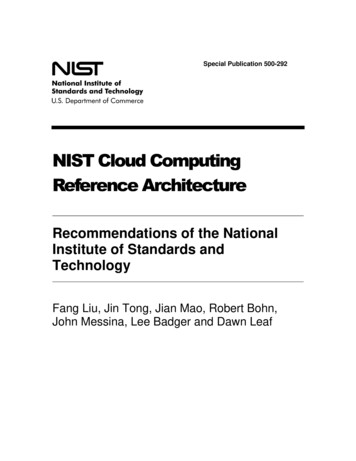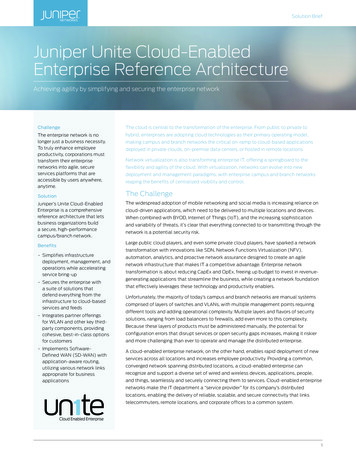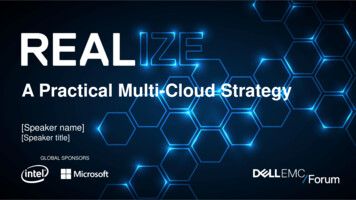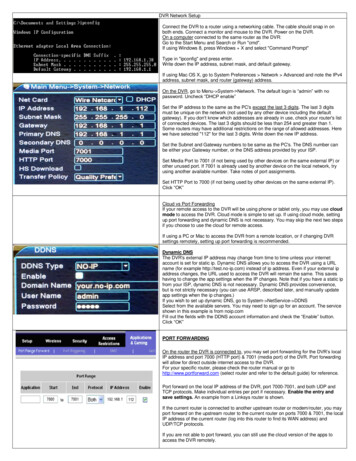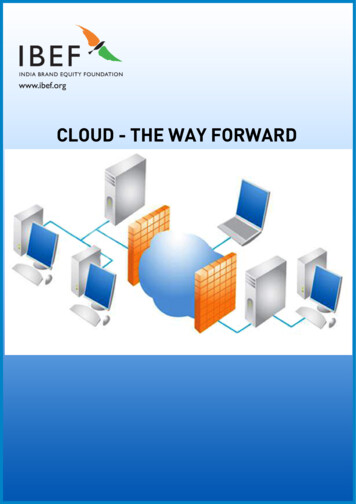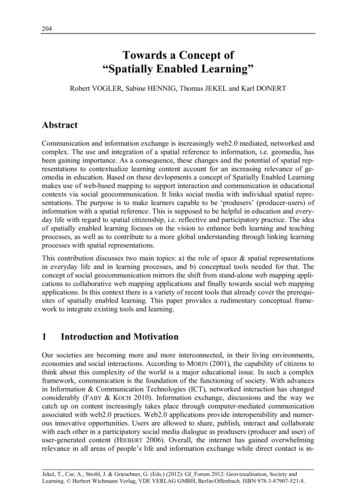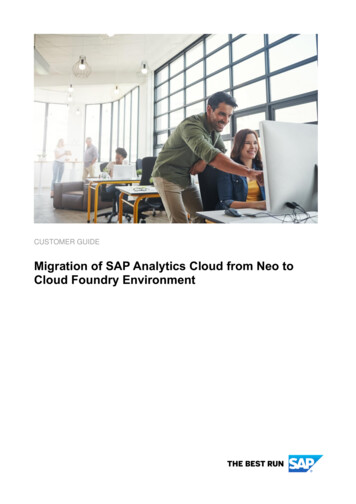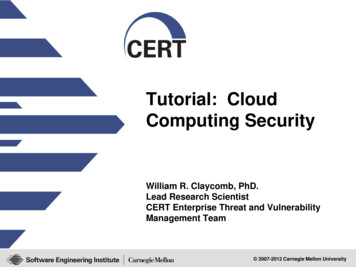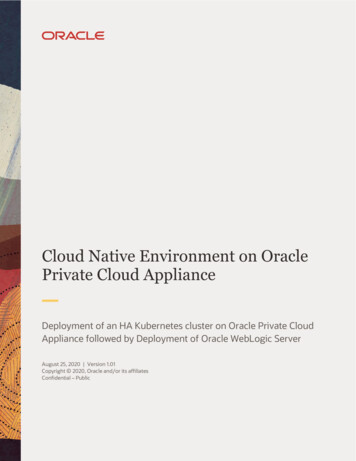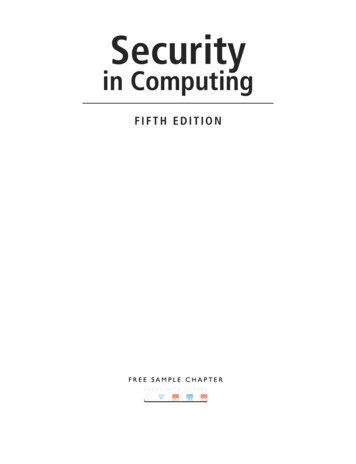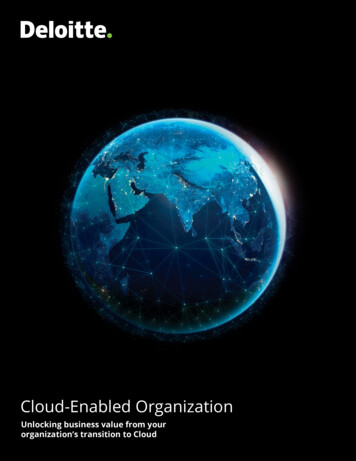
Transcription
Cloud-Enabled OrganizationUnlocking business value from yourorganization’s transition to Cloud
HUMAN CAPITAL CLOUD2Unlocking business valuefrom your organization’stransition to CloudUnderstanding the workforce and organizationimplications of your Cloud transformationIt’s a new world. The workforce is global. Organizational capabilities areglobal. Innovation at the speed of Cloud paves the way for businesstransformation so expansive that industries are changing.Like many organizations, you are likely to be somewhere along onyour Cloud journey. You may have already begun implementing Cloudtechnology in pockets of your organization, including Amazon WebServices (AWS), Google Cloud Platform (GCP), or Microsoft Azure.Organizations across industries and borders are leveraging the powerof Cloud, AI, and analytics to innovate, scale their business, and gaininsights about customers and operations. At the same time, theyhave learned that just focusing on technology and applications isnot enough to realize the return on investment (ROI) they want frommigrating to Cloud.So now what?To become a Cloud-enabled organization and realize the full ROIfrom Cloud, best-in-class leaders are looking beyond technology toanticipate wider organizational opportunities. They’re asking:NOW THAT WE’RE CONNECTED TO CLOUD, HOW CAN WETRANSFORM OUR WORKFORCE, OPERATING MODEL, ANDCULTURE TO TAKE FULL ADVANTAGE OF OUR INVESTMENT?New-world business is a human-centered, enterprise-wide strategy forengaging customers who demand integrated solutions—and employeeswho thrive on multidisciplinary insights. Customers and businessesalike are demanding solutions they know and use as consumers, likethose from social media companies, based on Cloud native technology.Organizations thriving on Cloud are all in.
HUMAN CAPITAL CLOUD3Success requirestransformationSuccess requires more than justdelivering Cloud technology; italso requires preparing yourworkforce to rethink work in aCloud-enabled environment andproviding the tools, skills, andprocesses they need to thrive.Humanizing theCloud: The keythat unlocks truebusiness valueWhile Cloud transformationhas presented technologicalchallenges, many organizationshave found change managementfor the human side of business tobe even more difficult. Technologyis borderless geographically andorganizationally, so new-worldorganizations need aworkforce skilled, equipped,and knowledgeable enough tocross borders, too. That meansusing Cloud-enabled machinelearning and communications toinform decision-making acrossthe enterprise.To realize full CloudROI, organizationsleave half-measuresbehindDarwin identified adaptabilityas a key capacity for thriving inany habitat. An organization’scompetitive advantage is similarlyproportional to its adaptabilityquotient—its ability to adapt tocontinually changing businessenvironments. Deloitte hasidentified workforce andorganizational enablers to helpaccelerate the ROI on your Cloudtransformation and leave you ina better position to unlock valuethroughout the enterprise.While not an exhaustive list, these five enablers of ROIare among the first to unlock business value from yourorganization’s transition to Change
HUMAN CAPITAL CLOUD4Deloitte’s 5 Human Capital ROI Enablers to leadand accelerate your Cloud transitionOrganization DesignDevelop an Organization and Functional partnershipwith IT, Cloud platforms and customersSiloed technical teams andunclear ownership and governanceof some applications driving poorefficiency and outcomesUnderstand the local needs and use ofstand-alone applicationsCapability DevelopmentScarcity of critical Cloud skillsand competencies within theorganization driving poor literacyand adoption of Cloud solutionsLeader-Led ChangeInsufficient buy in andendorsement from IT andbusiness leaders to maximizeadoption and business potentialEmploy multiple delivery modes to meet unitedand unique needsEstablish clear decision rights andgovernance structuresUnderstand and prioritize the key Cloud capability gapsAssess current capability and map team members intopotential future Cloud rolesTogether design development pathways to definea roadmap for transition to CloudDevelop a compelling narrative and case for changeUplift change leader capabilities to lead the transitionto Cloud from within the organizationDesign a future roadmap with unique andconsistent messagesRegularly gauge employee sentiment to build the rightconditions for constant changeCulture TransformationDetermine how digital the organization is andneeds to beThe organization is not digitallymature enough to support thecultural shift required for theuptake of new ways of workingCreate a blueprint that will help bring to life newor increasingly maturing Cloud DNA required to helpthe Cloud journeyWork Re-architectureEmpower workers with agency and choice over the workthey do to promote employee engagement and innovationStandardized workforceprocesses stifle innovation,ignore new tools, waste time,and delay ROIIntegrate humans and technology so teams usecomplimentary skills to re-architect workInfuse the required Cloud DNA into the existingDNA through a series of impactful minimum viablechanges (MVCs)Create more opportunities for learning, fun, creativity,and meaning at workUse real-time workforce insights to support better,faster decisions
HUMAN CAPITAL CLOUDOrganization designSilos left behind. Getting the most out of Cloud requires multidisciplinaryteams to learn and work together. Development accelerates when businessand technology work together, and Agile, multi-disciplinary teams leveragedata from more than one point of view. It requires matching ease of accesswith ease of understanding so leaders and teams can use data for insightfuldecision-making. And it requires democratizing data so everyone can accessit without gatekeepers and bottlenecks that slow everyone down.Organizations poised to unlock value from adaptability are asking:WHAT SHOULD OUR CLOUD OPERATING MODEL LOOK LIKE?HOW DO WE ENABLE OUR ORGANIZATION TO ACHIEVE BUSINESS GOALS?HOW CAN WE SUPPORT TEAMS TO BETTER COLLABORATE?To truly become a Cloud-enabled organization, a focus on technology is notenough. Leaders are also required to understand how individuals and teamsoperate within this environment. Deloitte’s Adaptable Organization NetworkAssessment (AONA) is a survey-based platform that examines and comparesnetwork connections, collaboration patterns, and formal structures toidentify areas of optimization or obstruction.Unlocking these invisible collaboration networks using AONA revealshow the organization operates, showing leaders which teams are preparedto work within a multi-disciplinary environment and which individuals orfunctions are acting as gatekeepers or bottlenecks and therefore requireincreased leadership effort. AONA shows you the path towards a Cloudenabled way of working.5
HUMAN CAPITAL CLOUD6Capability developmentSlow left behind. Cloud has one speed—fast—but underestimating the shiftrequired to access the full benefits of Cloud slows down ROI. Organizationspoised to unlock value from new workforce capabilities are asking:WHAT ARE THE CRITICAL SKILLS AND CAPABILITIES THAT MYORGANIZATION NEEDS TO BE SUCCESSFUL?WHAT TYPE OF SKILLS AND CAPABILITIES CAN BE LEARNED,DEVELOPED, AUGMENTED, OR AUTOMATED BY NEWCLOUD-ENABLED TECHNOLOGIES?To better understand workforce readiness to operate in a new Cloudenvironment, organizations need to understand the current Cloud capabilityand literacy of their workforce. Deloitte’s Cloud Workforce Analytics mapsthe organization’s current-state maturity against future-state aspirations todetermine capability gaps and make recommendations for bridging them.Transferable skillsWorkforce resilienceTraditional job training left behind. Rapid advances indigital, robotics, and cognitive and AI technologies,along with organization and workforce transformation,means organizations need to rethink how work andworkforces are designed and deployed. New talentmodels accelerate growth by identifying transferableskills held by existing people and new hires whilecreating meaningful careers for employees across theworkforce ecosystem. Organizations must identifytransferable skills talent brings to the organization andcreate pathways for workers to transition betweenindustries and roles.Job descriptions left behind. A worker developmentapproach that accepts the dynamic nature of new-worldjobs, and the equally dynamic potential of people toreinvent themselves, builds worker and organizationalresilience in the face of change. For example, lookingoutside of your IT organization toward the widerbusiness value of Cloud data helps you assess yourworkforce potential. Consider your front desk workers:with a capability uplift or reskilling, they can leverageCloud solutions to capture client data for guidingdecision-making.To thrive in an environment of constant and continuouschange, a truly adaptable organization works with“Cloud pods,” time-bound teams that adapt to takeon high-priority tasks based on data-driven feedback.Small groups of self-organizing people with a varietyof competencies can work collaboratively on deliveringmultiple iterations of a product.
HUMAN CAPITAL CLOUD7Leader-led changePatchwork change left behind. Organizational changeis ten times more likely to succeed when it is led fromwithin. Only leader-led change can engage the entireorganization in transformative, data-driven innovation.Technology changes alone are not enough. You only getthe full benefit of Cloud if you fully disrupt old-worldoperations. Leader-led change asks how to make peopleaware of Cloud capabilities that enhance rather thanreplace human capacities. It asks how to give peopletime to explore and co-design the new world. Leader-ledchange ensures that transformations support yourtarget operating model across the organization.Organizations poised to unlock value from leader-ledchange are also asking:HOW WELL EQUIPPED AM I TO DRIVECHANGE AND GUIDE THE ORGANIZATIONTHROUGH TRANSFORMATION?Step into your Cloudrole with confidenceBusiness as usual left behind. Because Cloud isnot business as usual, taking advantage ofoutside expertise is essential. To analyzewhere you are now and where Cloud can takeyou requires analytics and insights from expertswith deep experience. Breaking out of the oldways is only feasible with a trusted, experiencedpartner. Deloitte has been helping organizationsworld-wide to envision and execute Cloudtransformations with vigilance, multidimensionalthinking, and unrelenting commitmentto delivering value.WHAT ARE THE KEY CHANGES I HAVE TO MAKEAND WHAT SYSTEMS AND TOOLS DO I NEED TOENABLE THE TRANSITION TO CLOUD?HOW DO I SUPPORT MY BUSINESS ANDTECHNOLOGY TEAMS TO EMBRACE CHANGEAND WORK TOGETHER TO DELIVER RAPIDINNOVATION AND ENTERPRISE ABILITY?Working with Deloitte is not outsourcing change toexternal consultants; instead, it’s gaining the expertiseand tools you need to set a course to Cloud, track yourprogress, and sustain a productive change-managementjourney. By leveraging existing IT and equipping leaderswith core competencies to lead people through change,organizations are able to prepare their teams for newworld realities.CIOs driveleader-led changeTunnel vision left behind. The Deloitte 2020 GlobalLeadership Study including 1,300 participantsacross 69 countries and 22 industry sectors foundthat 69% of respondents expect tech leaders to beinstigators of organizational change.1While CIOs have a key role to play, leaders acrossthe organization need to take an active role inhelping employees understand Cloud strategy,embrace upskilling and development, and newways of working. As organizations embrace Cloud,leaders across the business and IT need to worktogether, often in a DevOps environment, to buildnew ways of collaborating, developing product,and innovating.
HUMAN CAPITAL CLOUD8Cultural transformationOld-school hierarchies left behind. Because yourculture defines who you are as an organization, culturalchange requires redefinition—in more than wordsalone. Culture is the way work gets done. Culture isthe behavior, techniques, experiences, and values theorganization works every day to sustain, repeat, refine,and pass on to new employees.Modernizing work means moving away from scriptedTaylorism to a culture of empowerment and Agility.Shifting workforce practices to worker preferences,working styles, and personal needs is foundational tocultural transformation. At the same time, new rewardstructures that acknowledge individual change andgrowth—and collaboration excellence—acceleratechange that supports transformation.Organizations poised to unlock value from culturechange are asking:WHAT IS THE CURRENT LEVEL OF READINESS TOSUPPORT THE CULTURAL SHIFT TO OPERATINGIN A MORE AGILE ENVIRONMENT?HOW CAN WE CREATE A CULTURE OFCONTINUOUS IMPROVEMENT?Cloud transformation fundamentally changes the waypeople work and therefore demands significantbehavioral change. Cloud-enabled work thrives oncollaboration. Replacing traditional function-basedteams build around hierarchies with multidisciplinarysquads focused on product outcomes is one waycultural change improves productivity. When employeesfeel they’re doing meaningful work with others and havethe tools they need to collaborate on productdevelopment, culture is business strategy brought to life.Organizational culture can also inhibit growth andundermine leaders’ attempts to drive change.Companies prevent stagnation when leaders activatechange across the organization with the right tools andexpertise. Deloitte employs analytics-based insights tohelp organizations manage culture change and equipthe workforce with competencies for capitalizing on yourtechnology investments.
HUMAN CAPITAL CLOUD9Work re-architectureStandardized workforce processes left behind. Reaching Cloud capacityand the necessary organization’s operating model changes is central fordelivering products and services. Taking small steps over years, so costlyand wasteful, is a thing of the past. Half measures waste time and delay ROI.Thriving organizations don’t evolve—they reinvent. To truly become humanat their core, organizations are re-architecting work across the enterprise,collaborating with business and other functional leaders to reimagine work.Work changes as a consequence of having new tools. Doing Cloud rightmeans empowering people to use artificial intelligence and machine learningto make impacts in new ways. The “Superteams” trend from the DeloitteHuman Capital Trends report finds that pairing people with technology inmore human ways has a key role to play in re-architecting work to achievegreater efficiency:“.the insurance industry is using AI and predictive modeling to assist underwriters withdata-driven risk assessment. Underwriters don’t have to become tech experts or datascientists to use and benefit from the technology. They only need to understand howand when to leverage AI-assisted solutions to accomplish the work more effectively.”1Organizations poised to unlock value from work redesign are asking:HOW DO WE REDESIGN WORK AS A COMPETITIVE ADVANTAGE FORGLOBAL LEADERSHIP?Executives are reimagining workand preparing their organizations tothrive while adapting to change withfour key strategies:Empowering workers with agencyand choice over what work they do,unleashing their potential by allowingthem to apply their interests andpassions to organizational needsIntegrating humans and technologyso teams use their complementarycapabilities to re-architect work in morehuman waysUsing real-time workforce insights thatcan support better, faster decisions.While off-Cloud work enables monthlyor annual deployment of new productsand services, on-Cloud deployment canbe hourly, daily, and weeklyHOW CAN WE CREATE MORE OPPORTUNITIES FOR LEARNING, FUN,CREATIVITY AND MEANING AT WORK?HOW CAN PEOPLE, DATA, AI, AND MACHINE LEARNING COMPLEMENTEACH OTHER’S CAPACITIES?Embracing an enterprise mindsetthat prioritizes re-architecting work tocapitalize on unique human strengths 2The new world of work revolves around more choice about when and where people complete their work.Models have reimagined flexibility to include trusting employees to determine their work environmentsand empowering them to discover emergent capacities.Critical workforceprioritiesWorkers have something thatdoesn’t appear on a resumeRigidity left behind. Critical workforce priorities emphasizeclient, customer, and end-user awareness—and creativitythat relies on critical thinking, emotional intelligence,and collaboration.3 As a result, Intelligence Quotientsand Emotion Quotients are making way for AdaptabilityQuotients: the ability to work in Agile-empowered,multidisciplinary, entrepreneurial teams.Value-add left behind. People bring capabilities that addvalue to the organization, but the organization must inviteand enable individuals’ value to multiply. The newworkforce must be more empowered to explore, trustedto test and learn, invited to collaborate in multidisciplinaryteams, and supported in their collaborative andindividual efforts.
HUMAN CAPITAL CLOUD10Uniquely DeloitteMultidimensional solutions acrossborders and industriesDeloitte’s Cloud transformation teams collaborate with your organizationto map and execute leader-led change, focusing on operating model,workforce, culture, and work re-architecture.Deloitte Enablers of ROI chart a clear a path to maximizing returns fromCloud transformation. A case in point: Deloitte Human Capital partneredwith a banking enterprise to deploy an adaptable strategy to meet customerneeds as they changed and to take advantage of market opportunities asthey emerged.A multidimensional solution addressed the client’s operating model, culture,change management, Agile workforce innovation, organization design, andtechnology requirements.Value Delivered:Highly engaged andcollaborative teams thatvalue communicationover processes & toolsFast moving teamsresponsive to changes instrategy, regulation, andcustomer needsNew mindset for creativethinking, innovation,experimentation and“fail/learn fast”Iterative development forfaster proof of conceptand value delivery: threefold increase in averagedevelopment velocity30%27821%180%reduction of effortneeded for governanceactivitiesimprovements identifiedfor the transformationroadmapreduction inscope due toAgile prioritizationimprovement innet promoter scoresacross teams
HUMAN CAPITAL CLOUDDeloitte solutions unlock businessvalue across your organizationPut these tools to work to help your enterprisethink big, start small, and scale fast.Adaptable Organization Network Analysis AssetsA survey-based platform that examines network connections to shed light on the informalorganization that is not visible in org chartsCloud Workforce AnalyticsFor making better talent decisions, designing training, shifting roles, and targeting new hiresValue Stream MappingIdentifies where you can eliminate waste and bring efficiencies to lifeChangeScoutAccelerates and simplifies complex change programs in real timeDigital DNAIdentifies current capabilities, visualizes your organization’s current digital DNA maturity for eachof the 23 traits, and prioritizes a few imperative digital traits needed by the enterpriseCloud Transformation FrameworkHelps provide a structured and coherent approach for establishing and maturing capabilities forthe Cloud transformation lifecycleDevOps Automated ProvisioningDelivers computing capacity on-demand without manual intervention. Provides the foundationfor a flexible, extensible infrastructure with dynamic resource allocation across the enterprise,enabling app delivery at the speed of digital services11
HUMAN CAPITAL CLOUD12Deloitte is recognized as a global leaderDeloitte knowledge and experience crosses borders and markets withassessment tools and solutions informed by cultural expectations andregulatory policies.Deloitte named aglobal leader in PublicCloud InfrastructureProfessional andManaged Services basedon completeness ofvision and abilityto execute4Deloitte nameda global leader inCommunications andChange ManagementConsulting based onbreadth and depthof capabilities5ContactsContact one of our leaders and they willconnect you with the right professional basedon where you are on your journey.Martin KamenPrincipal, Human CapitalCloud Leadermkamen@deloitte.comYves Van DurmePartner, Global OrganizationTransformation Leaderyvandurme@deloitte.comTom AlsteinPartner, uLearn more ancapitalDeloitte nameda global leader inWorkforce ManagementConsulting based onbreadth and depthof capabilities6Deloitte namedthe undisputed globalleader in IT OperationsConsulting basedon breadth and depthof capabilities7
Endnotes1.Erica Volini, Jeff Schwartz, Kraig Eaton, David Mallon, Yves Van Durme, Maren Hauptmann, Rob Scott, and Shannon Poynton.Superteams: Where work happens, The 2021 Global Human Capital Trends. Deloitte Insights, 2021.2.Elise Sharply, Kirsty Miller, Sophie Simpson, Liz Dunne. Re-architecting Work Models: Four Future Worlds of Work,Deloitte, 2020.3.Khalid Kark, Ahn Nguyen Phillips, Bill Briggs, Mark Lillie, John Tweardy, and Scott Buchholz. Deloitte 2020 Global LeadershipStudy. Deloitte Insights, 2020.4.Gartner, Magic Quadrant for Public Cloud Infrastructure Professional and Managed Services, Worldwide, May 2020.5.ALM Intelligence, The ALM Vanguard: Communications and Change Management Consulting, March 2018.6.ALM Intelligence, The ALM Vanguard: Workforce Management Consulting 2019, May 2019.7.ALM Intelligence, The ALM Outlook: IT Operations Consulting 2018, December 2018.Deloitte refers to one or more of Deloitte Touche Tohmatsu Limited, a UK private company limited by guarantee(“DTTL”), its network of member firms, and their related entities. DTTL and each of its member firms are legally separateand independent entities. DTTL (also referred to as “Deloitte Global”) does not provide services to clients. In the UnitedStates, Deloitte refers to one or more of the US member firms of DTTL, their related entities that operate using the“Deloitte” name in the United States and their respective affiliates. Certain services may not be available to attest clientsunder the rules and regulations of public accounting. Please see www.deloitte.com/about to learn more about ourglobal network of member firms.This communication contains general information only, and none of Deloitte Touche Tohmatsu Limited (“DTTL”), itsglobal network of member firms or their related entities (collectively, the “Deloitte organization”) is, by means of thiscommunication, rendering professional advice or services. Before making any decision or taking any action that may affect your finances or your business, you should consult a qualified professional adviser. No representations, warrantiesor undertakings (express or implied) are given as to the accuracy or completeness of the information in this communication, and none of DTTL, its member firms, related entities, employees or agents shall be liable or responsible for anyloss or damage whatsoever arising directly or indirectly in connection with any person relying on this communication.DTTL and each of its member firms, and their related entities, are legally separate and independent entities. 2021. For information, contact Deloitte Global.
complimentary skills to re-architect work Create more opportunities for learning, fun, creativity, and meaning at work Use real-time workforce insights to support better, faster decisions Siloed technical teams and unclear ownership and governance of some applications driving poor efficiency and outcomes Scarcity of critical Cloud skills

